Change Management Report: Strategies for Business Improvement
VerifiedAdded on 2020/07/22
|18
|5534
|42
Report
AI Summary
This report delves into the multifaceted realm of change management within the business environment, emphasizing the dynamic nature of market conditions and the imperative for leaders to adeptly navigate transformations. The report provides a comparative analysis of two UK-based tour operators, Thomas Cook and Cosmos Tours, evaluating the impact of change on their strategic operations, including external factors like government policies and customer preferences, and internal factors like structural adjustments and emerging technologies. It then assesses how internal and external drivers influence leadership, team dynamics, and individual behaviors, highlighting the significance of customer-led, technology-led, investor-led, competitor-led, and government-led drivers. Moreover, the report examines how to minimize the negative impacts of change by utilizing tools like PEST analysis and the evaluation of strengths, and the different barriers of change. Finally, it explores various leadership approaches in managing change, offering a comprehensive understanding of effective strategies for organizational adaptation and success.
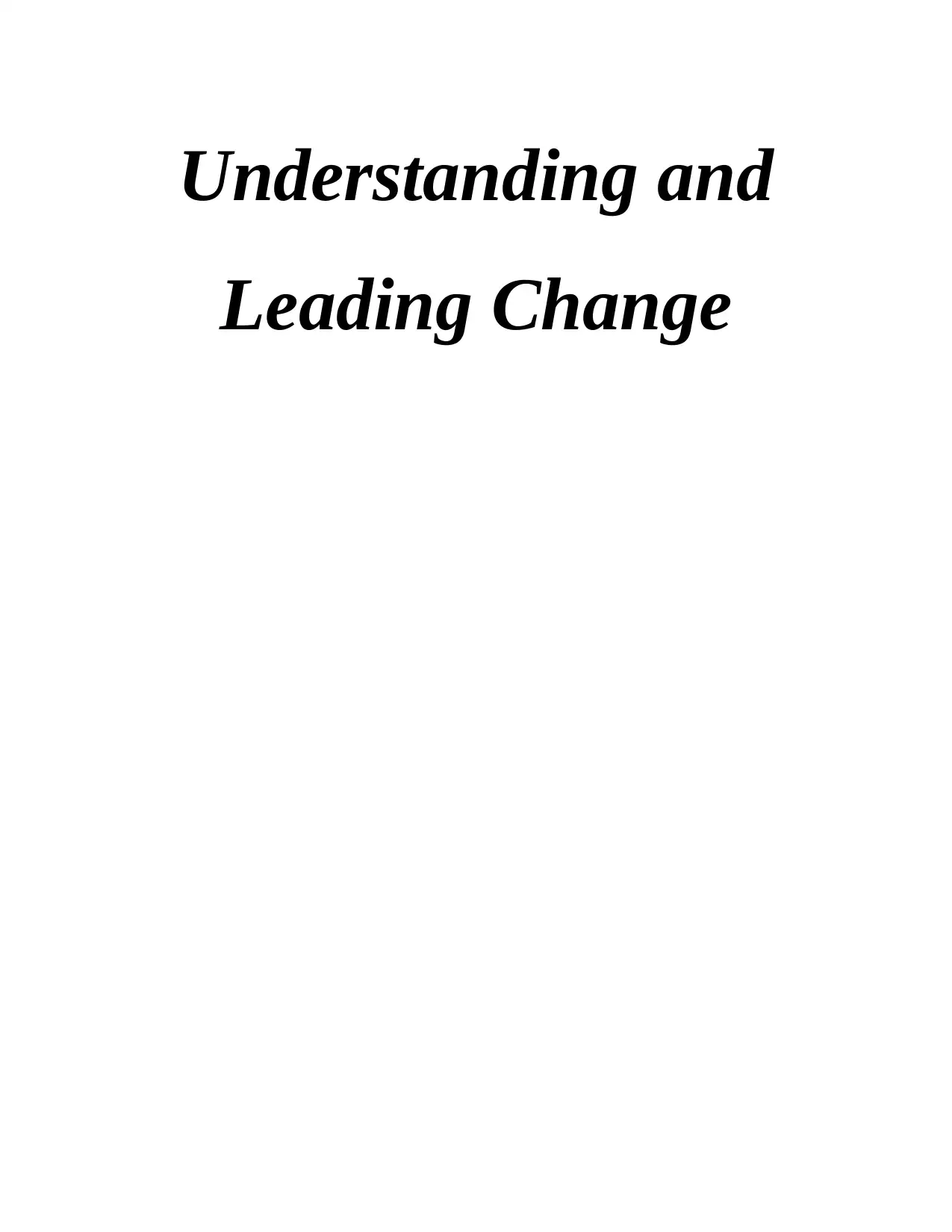
Understanding and
Leading Change
Leading Change
Paraphrase This Document
Need a fresh take? Get an instant paraphrase of this document with our AI Paraphraser
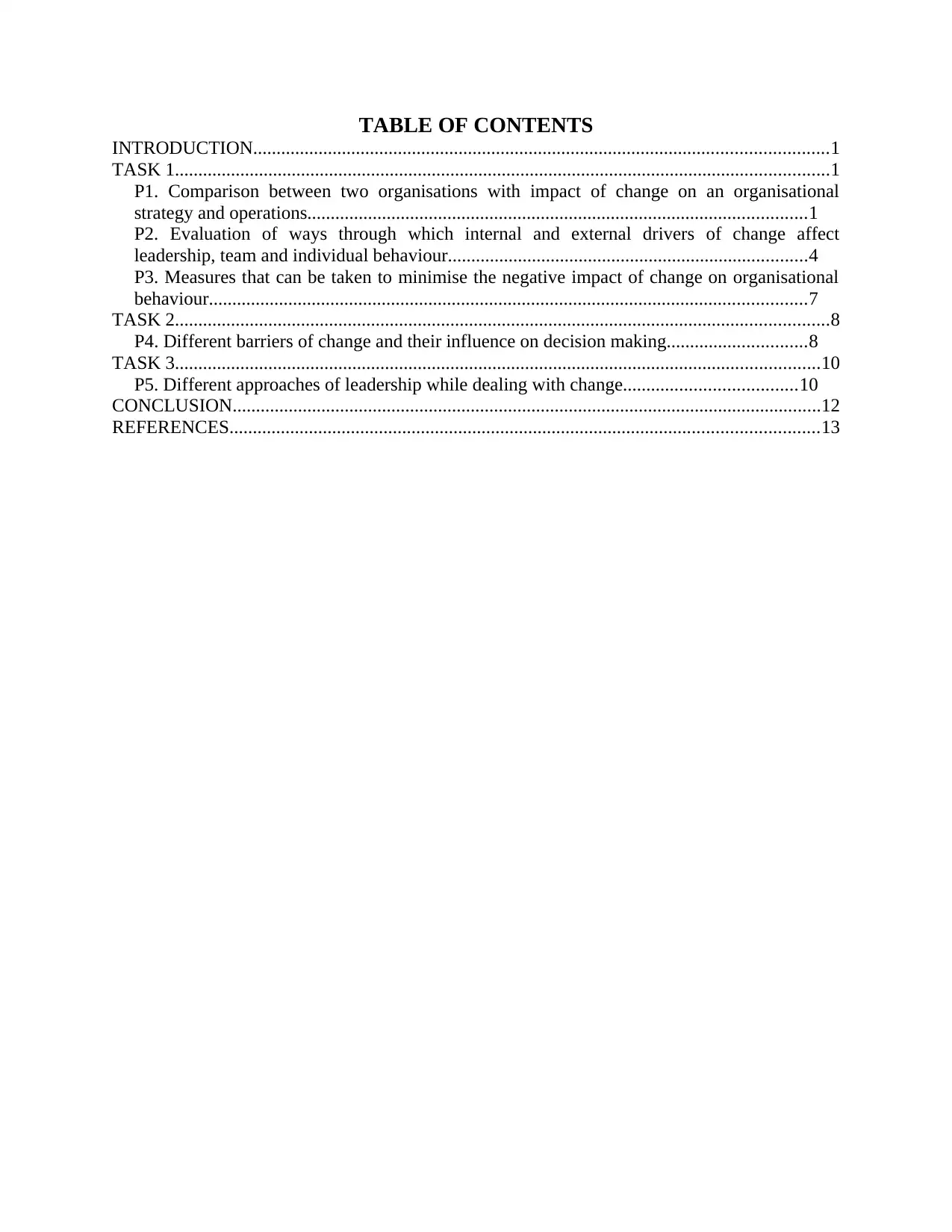
TABLE OF CONTENTS
INTRODUCTION...........................................................................................................................1
TASK 1............................................................................................................................................1
P1. Comparison between two organisations with impact of change on an organisational
strategy and operations...........................................................................................................1
P2. Evaluation of ways through which internal and external drivers of change affect
leadership, team and individual behaviour.............................................................................4
P3. Measures that can be taken to minimise the negative impact of change on organisational
behaviour................................................................................................................................7
TASK 2............................................................................................................................................8
P4. Different barriers of change and their influence on decision making..............................8
TASK 3..........................................................................................................................................10
P5. Different approaches of leadership while dealing with change.....................................10
CONCLUSION..............................................................................................................................12
REFERENCES..............................................................................................................................13
INTRODUCTION...........................................................................................................................1
TASK 1............................................................................................................................................1
P1. Comparison between two organisations with impact of change on an organisational
strategy and operations...........................................................................................................1
P2. Evaluation of ways through which internal and external drivers of change affect
leadership, team and individual behaviour.............................................................................4
P3. Measures that can be taken to minimise the negative impact of change on organisational
behaviour................................................................................................................................7
TASK 2............................................................................................................................................8
P4. Different barriers of change and their influence on decision making..............................8
TASK 3..........................................................................................................................................10
P5. Different approaches of leadership while dealing with change.....................................10
CONCLUSION..............................................................................................................................12
REFERENCES..............................................................................................................................13
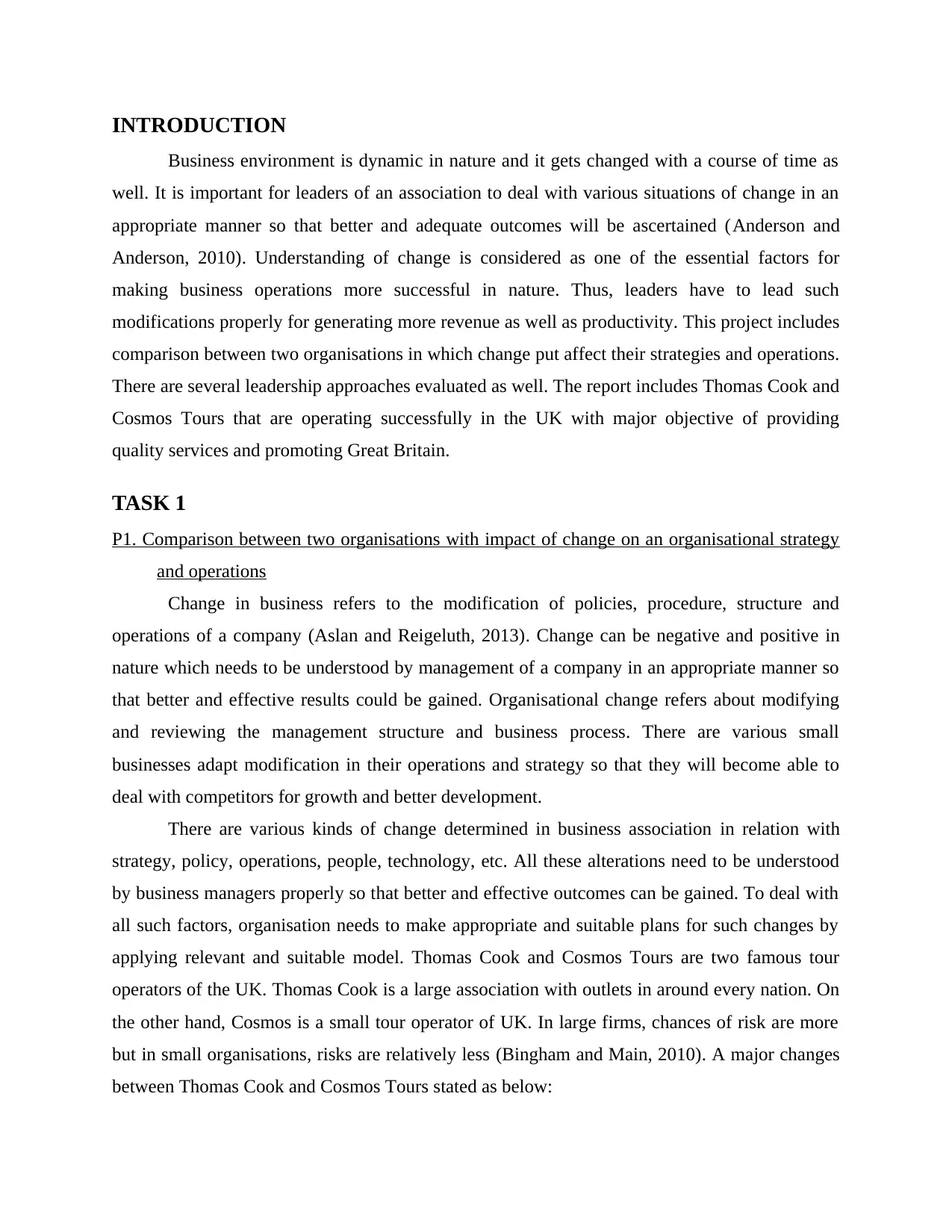
INTRODUCTION
Business environment is dynamic in nature and it gets changed with a course of time as
well. It is important for leaders of an association to deal with various situations of change in an
appropriate manner so that better and adequate outcomes will be ascertained (Anderson and
Anderson, 2010). Understanding of change is considered as one of the essential factors for
making business operations more successful in nature. Thus, leaders have to lead such
modifications properly for generating more revenue as well as productivity. This project includes
comparison between two organisations in which change put affect their strategies and operations.
There are several leadership approaches evaluated as well. The report includes Thomas Cook and
Cosmos Tours that are operating successfully in the UK with major objective of providing
quality services and promoting Great Britain.
TASK 1
P1. Comparison between two organisations with impact of change on an organisational strategy
and operations
Change in business refers to the modification of policies, procedure, structure and
operations of a company (Aslan and Reigeluth, 2013). Change can be negative and positive in
nature which needs to be understood by management of a company in an appropriate manner so
that better and effective results could be gained. Organisational change refers about modifying
and reviewing the management structure and business process. There are various small
businesses adapt modification in their operations and strategy so that they will become able to
deal with competitors for growth and better development.
There are various kinds of change determined in business association in relation with
strategy, policy, operations, people, technology, etc. All these alterations need to be understood
by business managers properly so that better and effective outcomes can be gained. To deal with
all such factors, organisation needs to make appropriate and suitable plans for such changes by
applying relevant and suitable model. Thomas Cook and Cosmos Tours are two famous tour
operators of the UK. Thomas Cook is a large association with outlets in around every nation. On
the other hand, Cosmos is a small tour operator of UK. In large firms, chances of risk are more
but in small organisations, risks are relatively less (Bingham and Main, 2010). A major changes
between Thomas Cook and Cosmos Tours stated as below:
Business environment is dynamic in nature and it gets changed with a course of time as
well. It is important for leaders of an association to deal with various situations of change in an
appropriate manner so that better and adequate outcomes will be ascertained (Anderson and
Anderson, 2010). Understanding of change is considered as one of the essential factors for
making business operations more successful in nature. Thus, leaders have to lead such
modifications properly for generating more revenue as well as productivity. This project includes
comparison between two organisations in which change put affect their strategies and operations.
There are several leadership approaches evaluated as well. The report includes Thomas Cook and
Cosmos Tours that are operating successfully in the UK with major objective of providing
quality services and promoting Great Britain.
TASK 1
P1. Comparison between two organisations with impact of change on an organisational strategy
and operations
Change in business refers to the modification of policies, procedure, structure and
operations of a company (Aslan and Reigeluth, 2013). Change can be negative and positive in
nature which needs to be understood by management of a company in an appropriate manner so
that better and effective results could be gained. Organisational change refers about modifying
and reviewing the management structure and business process. There are various small
businesses adapt modification in their operations and strategy so that they will become able to
deal with competitors for growth and better development.
There are various kinds of change determined in business association in relation with
strategy, policy, operations, people, technology, etc. All these alterations need to be understood
by business managers properly so that better and effective outcomes can be gained. To deal with
all such factors, organisation needs to make appropriate and suitable plans for such changes by
applying relevant and suitable model. Thomas Cook and Cosmos Tours are two famous tour
operators of the UK. Thomas Cook is a large association with outlets in around every nation. On
the other hand, Cosmos is a small tour operator of UK. In large firms, chances of risk are more
but in small organisations, risks are relatively less (Bingham and Main, 2010). A major changes
between Thomas Cook and Cosmos Tours stated as below:
⊘ This is a preview!⊘
Do you want full access?
Subscribe today to unlock all pages.

Trusted by 1+ million students worldwide
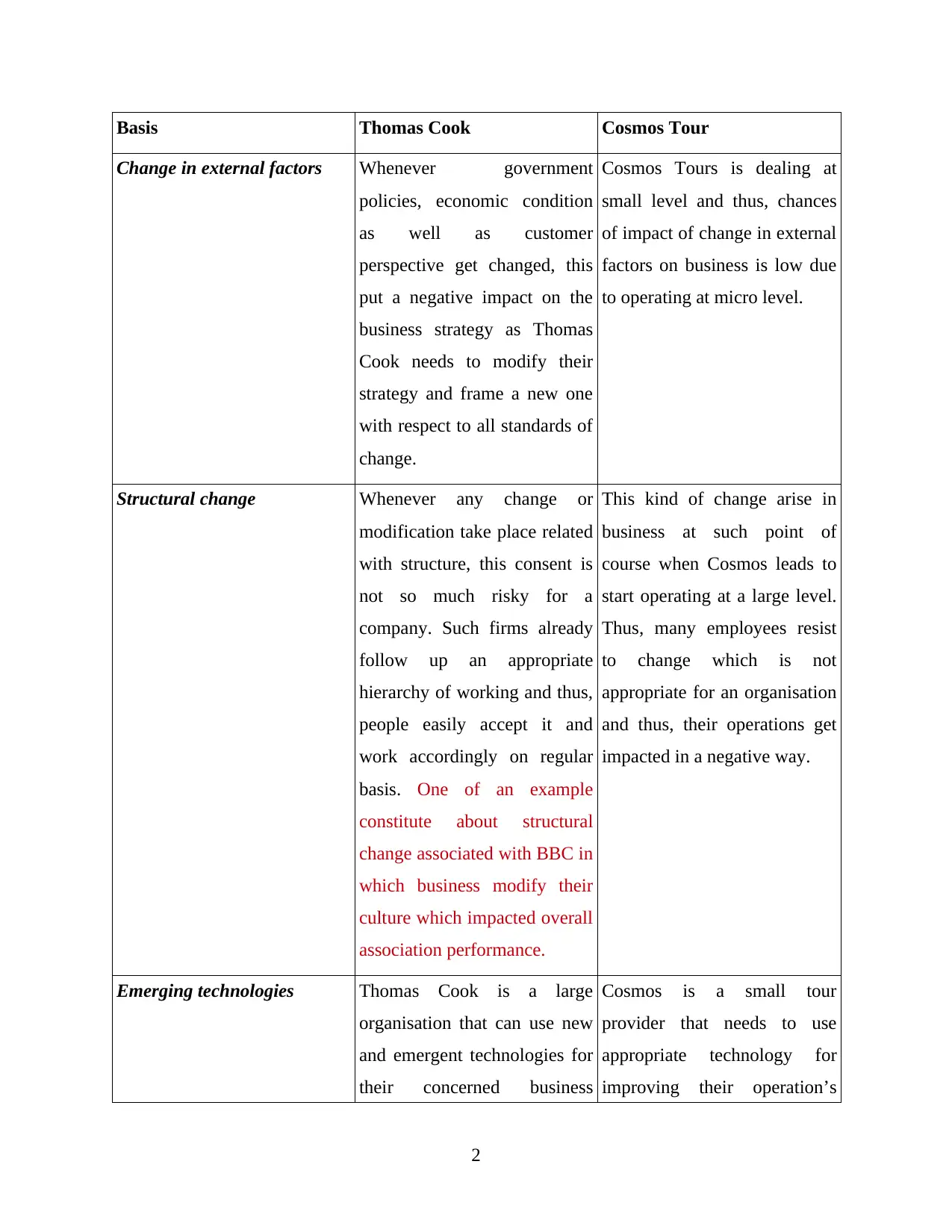
Basis Thomas Cook Cosmos Tour
Change in external factors Whenever government
policies, economic condition
as well as customer
perspective get changed, this
put a negative impact on the
business strategy as Thomas
Cook needs to modify their
strategy and frame a new one
with respect to all standards of
change.
Cosmos Tours is dealing at
small level and thus, chances
of impact of change in external
factors on business is low due
to operating at micro level.
Structural change Whenever any change or
modification take place related
with structure, this consent is
not so much risky for a
company. Such firms already
follow up an appropriate
hierarchy of working and thus,
people easily accept it and
work accordingly on regular
basis. One of an example
constitute about structural
change associated with BBC in
which business modify their
culture which impacted overall
association performance.
This kind of change arise in
business at such point of
course when Cosmos leads to
start operating at a large level.
Thus, many employees resist
to change which is not
appropriate for an organisation
and thus, their operations get
impacted in a negative way.
Emerging technologies Thomas Cook is a large
organisation that can use new
and emergent technologies for
their concerned business
Cosmos is a small tour
provider that needs to use
appropriate technology for
improving their operation’s
2
Change in external factors Whenever government
policies, economic condition
as well as customer
perspective get changed, this
put a negative impact on the
business strategy as Thomas
Cook needs to modify their
strategy and frame a new one
with respect to all standards of
change.
Cosmos Tours is dealing at
small level and thus, chances
of impact of change in external
factors on business is low due
to operating at micro level.
Structural change Whenever any change or
modification take place related
with structure, this consent is
not so much risky for a
company. Such firms already
follow up an appropriate
hierarchy of working and thus,
people easily accept it and
work accordingly on regular
basis. One of an example
constitute about structural
change associated with BBC in
which business modify their
culture which impacted overall
association performance.
This kind of change arise in
business at such point of
course when Cosmos leads to
start operating at a large level.
Thus, many employees resist
to change which is not
appropriate for an organisation
and thus, their operations get
impacted in a negative way.
Emerging technologies Thomas Cook is a large
organisation that can use new
and emergent technologies for
their concerned business
Cosmos is a small tour
provider that needs to use
appropriate technology for
improving their operation’s
2
Paraphrase This Document
Need a fresh take? Get an instant paraphrase of this document with our AI Paraphraser
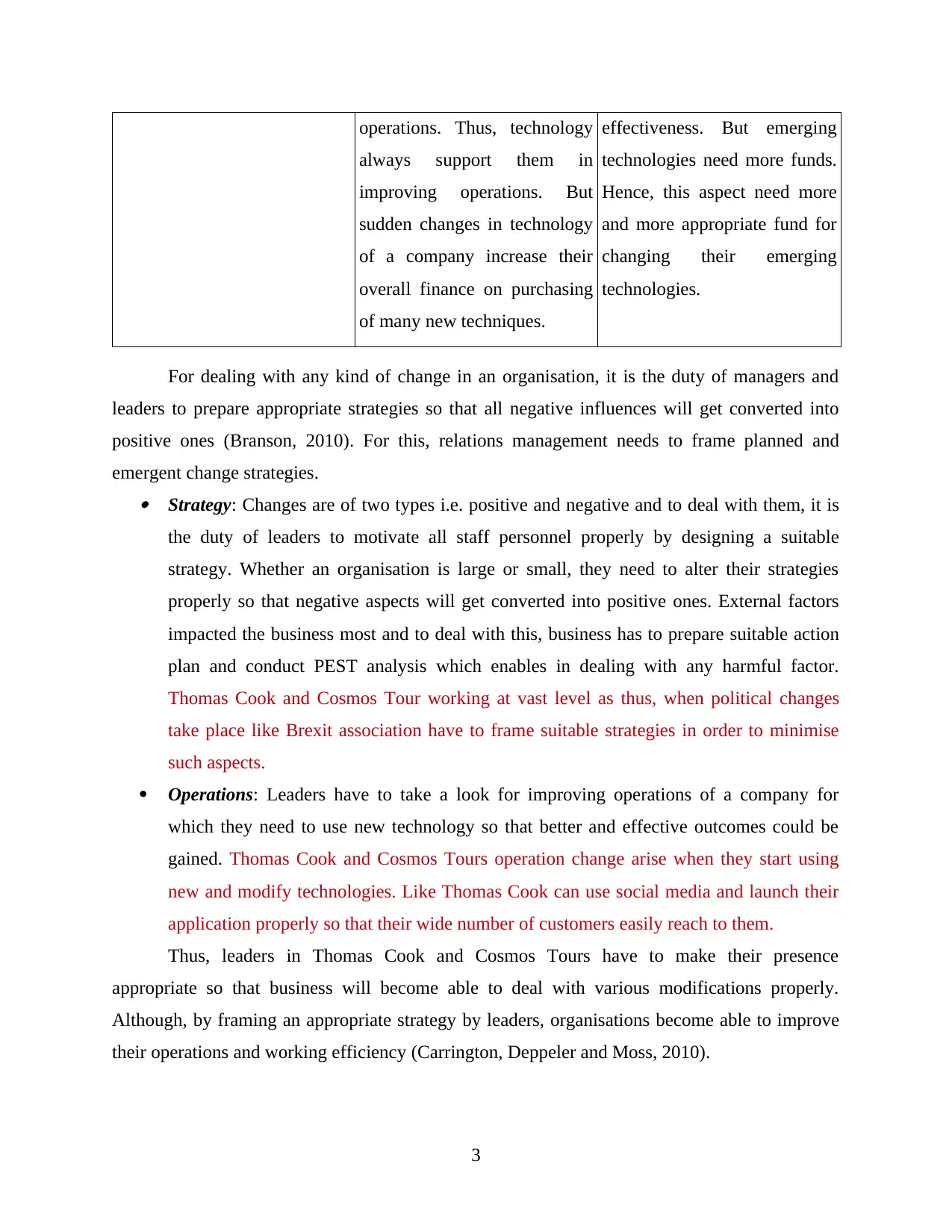
operations. Thus, technology
always support them in
improving operations. But
sudden changes in technology
of a company increase their
overall finance on purchasing
of many new techniques.
effectiveness. But emerging
technologies need more funds.
Hence, this aspect need more
and more appropriate fund for
changing their emerging
technologies.
For dealing with any kind of change in an organisation, it is the duty of managers and
leaders to prepare appropriate strategies so that all negative influences will get converted into
positive ones (Branson, 2010). For this, relations management needs to frame planned and
emergent change strategies. Strategy: Changes are of two types i.e. positive and negative and to deal with them, it is
the duty of leaders to motivate all staff personnel properly by designing a suitable
strategy. Whether an organisation is large or small, they need to alter their strategies
properly so that negative aspects will get converted into positive ones. External factors
impacted the business most and to deal with this, business has to prepare suitable action
plan and conduct PEST analysis which enables in dealing with any harmful factor.
Thomas Cook and Cosmos Tour working at vast level as thus, when political changes
take place like Brexit association have to frame suitable strategies in order to minimise
such aspects.
Operations: Leaders have to take a look for improving operations of a company for
which they need to use new technology so that better and effective outcomes could be
gained. Thomas Cook and Cosmos Tours operation change arise when they start using
new and modify technologies. Like Thomas Cook can use social media and launch their
application properly so that their wide number of customers easily reach to them.
Thus, leaders in Thomas Cook and Cosmos Tours have to make their presence
appropriate so that business will become able to deal with various modifications properly.
Although, by framing an appropriate strategy by leaders, organisations become able to improve
their operations and working efficiency (Carrington, Deppeler and Moss, 2010).
3
always support them in
improving operations. But
sudden changes in technology
of a company increase their
overall finance on purchasing
of many new techniques.
effectiveness. But emerging
technologies need more funds.
Hence, this aspect need more
and more appropriate fund for
changing their emerging
technologies.
For dealing with any kind of change in an organisation, it is the duty of managers and
leaders to prepare appropriate strategies so that all negative influences will get converted into
positive ones (Branson, 2010). For this, relations management needs to frame planned and
emergent change strategies. Strategy: Changes are of two types i.e. positive and negative and to deal with them, it is
the duty of leaders to motivate all staff personnel properly by designing a suitable
strategy. Whether an organisation is large or small, they need to alter their strategies
properly so that negative aspects will get converted into positive ones. External factors
impacted the business most and to deal with this, business has to prepare suitable action
plan and conduct PEST analysis which enables in dealing with any harmful factor.
Thomas Cook and Cosmos Tour working at vast level as thus, when political changes
take place like Brexit association have to frame suitable strategies in order to minimise
such aspects.
Operations: Leaders have to take a look for improving operations of a company for
which they need to use new technology so that better and effective outcomes could be
gained. Thomas Cook and Cosmos Tours operation change arise when they start using
new and modify technologies. Like Thomas Cook can use social media and launch their
application properly so that their wide number of customers easily reach to them.
Thus, leaders in Thomas Cook and Cosmos Tours have to make their presence
appropriate so that business will become able to deal with various modifications properly.
Although, by framing an appropriate strategy by leaders, organisations become able to improve
their operations and working efficiency (Carrington, Deppeler and Moss, 2010).
3
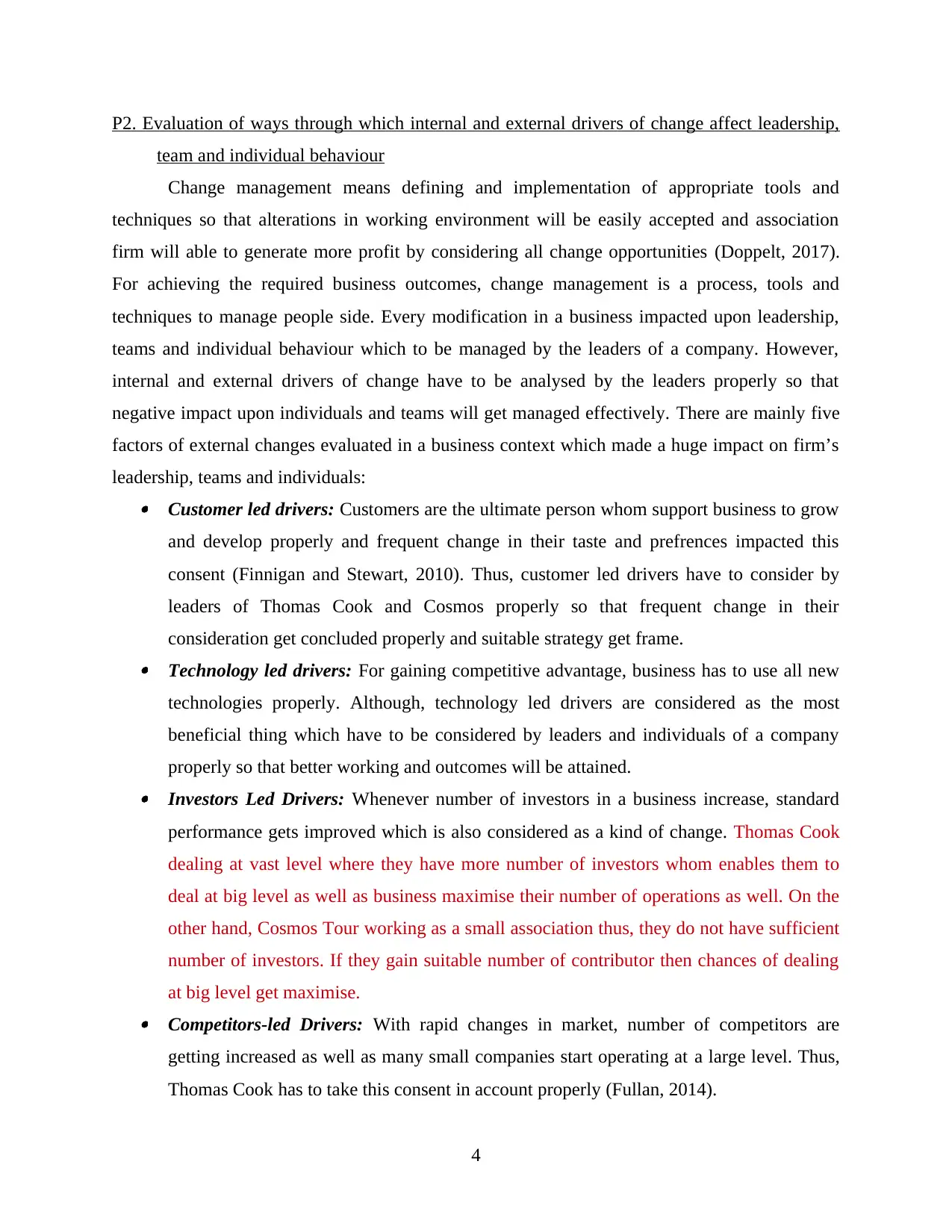
P2. Evaluation of ways through which internal and external drivers of change affect leadership,
team and individual behaviour
Change management means defining and implementation of appropriate tools and
techniques so that alterations in working environment will be easily accepted and association
firm will able to generate more profit by considering all change opportunities (Doppelt, 2017).
For achieving the required business outcomes, change management is a process, tools and
techniques to manage people side. Every modification in a business impacted upon leadership,
teams and individual behaviour which to be managed by the leaders of a company. However,
internal and external drivers of change have to be analysed by the leaders properly so that
negative impact upon individuals and teams will get managed effectively. There are mainly five
factors of external changes evaluated in a business context which made a huge impact on firm’s
leadership, teams and individuals: Customer led drivers: Customers are the ultimate person whom support business to grow
and develop properly and frequent change in their taste and prefrences impacted this
consent (Finnigan and Stewart, 2010). Thus, customer led drivers have to consider by
leaders of Thomas Cook and Cosmos properly so that frequent change in their
consideration get concluded properly and suitable strategy get frame. Technology led drivers: For gaining competitive advantage, business has to use all new
technologies properly. Although, technology led drivers are considered as the most
beneficial thing which have to be considered by leaders and individuals of a company
properly so that better working and outcomes will be attained. Investors Led Drivers: Whenever number of investors in a business increase, standard
performance gets improved which is also considered as a kind of change. Thomas Cook
dealing at vast level where they have more number of investors whom enables them to
deal at big level as well as business maximise their number of operations as well. On the
other hand, Cosmos Tour working as a small association thus, they do not have sufficient
number of investors. If they gain suitable number of contributor then chances of dealing
at big level get maximise. Competitors-led Drivers: With rapid changes in market, number of competitors are
getting increased as well as many small companies start operating at a large level. Thus,
Thomas Cook has to take this consent in account properly (Fullan, 2014).
4
team and individual behaviour
Change management means defining and implementation of appropriate tools and
techniques so that alterations in working environment will be easily accepted and association
firm will able to generate more profit by considering all change opportunities (Doppelt, 2017).
For achieving the required business outcomes, change management is a process, tools and
techniques to manage people side. Every modification in a business impacted upon leadership,
teams and individual behaviour which to be managed by the leaders of a company. However,
internal and external drivers of change have to be analysed by the leaders properly so that
negative impact upon individuals and teams will get managed effectively. There are mainly five
factors of external changes evaluated in a business context which made a huge impact on firm’s
leadership, teams and individuals: Customer led drivers: Customers are the ultimate person whom support business to grow
and develop properly and frequent change in their taste and prefrences impacted this
consent (Finnigan and Stewart, 2010). Thus, customer led drivers have to consider by
leaders of Thomas Cook and Cosmos properly so that frequent change in their
consideration get concluded properly and suitable strategy get frame. Technology led drivers: For gaining competitive advantage, business has to use all new
technologies properly. Although, technology led drivers are considered as the most
beneficial thing which have to be considered by leaders and individuals of a company
properly so that better working and outcomes will be attained. Investors Led Drivers: Whenever number of investors in a business increase, standard
performance gets improved which is also considered as a kind of change. Thomas Cook
dealing at vast level where they have more number of investors whom enables them to
deal at big level as well as business maximise their number of operations as well. On the
other hand, Cosmos Tour working as a small association thus, they do not have sufficient
number of investors. If they gain suitable number of contributor then chances of dealing
at big level get maximise. Competitors-led Drivers: With rapid changes in market, number of competitors are
getting increased as well as many small companies start operating at a large level. Thus,
Thomas Cook has to take this consent in account properly (Fullan, 2014).
4
⊘ This is a preview!⊘
Do you want full access?
Subscribe today to unlock all pages.

Trusted by 1+ million students worldwide
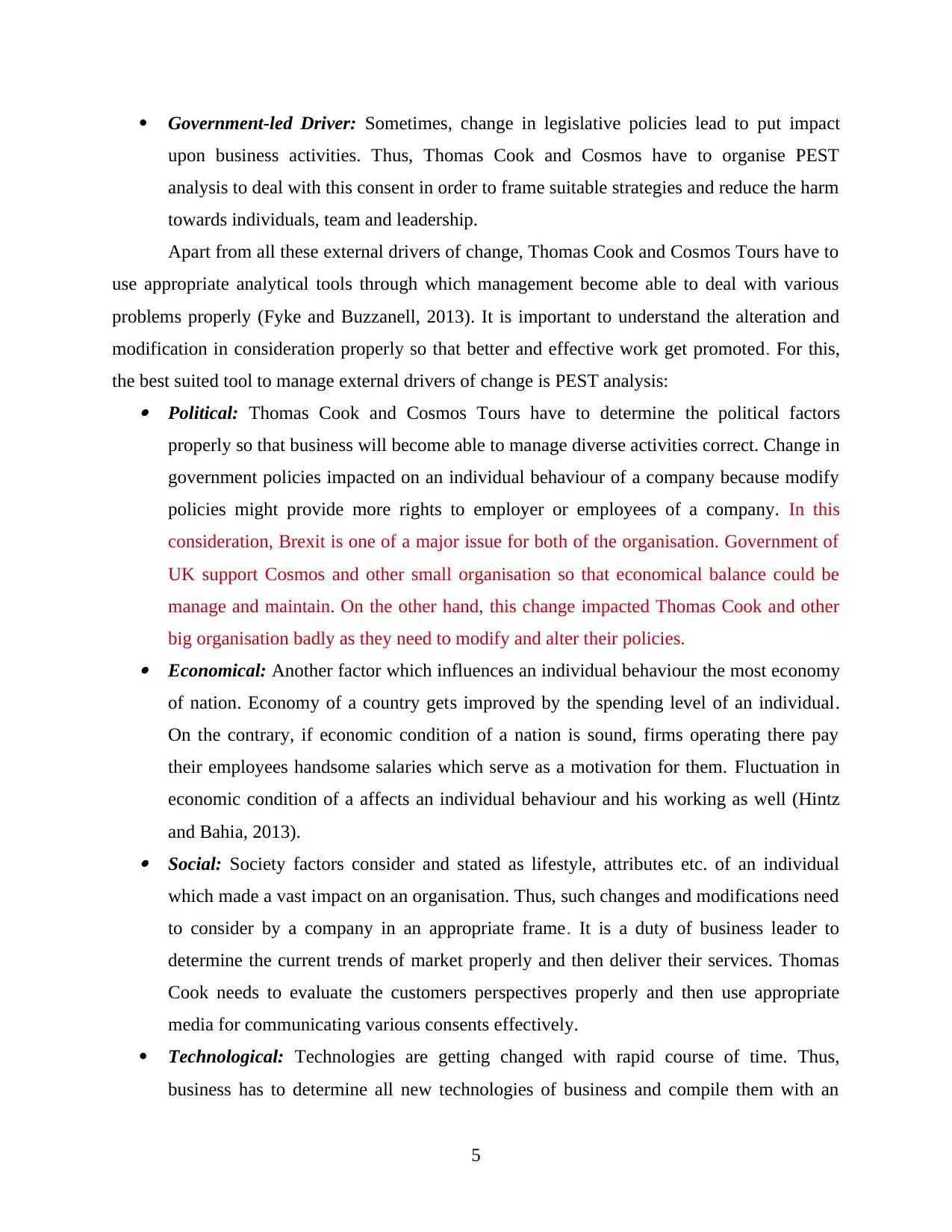
Government-led Driver: Sometimes, change in legislative policies lead to put impact
upon business activities. Thus, Thomas Cook and Cosmos have to organise PEST
analysis to deal with this consent in order to frame suitable strategies and reduce the harm
towards individuals, team and leadership.
Apart from all these external drivers of change, Thomas Cook and Cosmos Tours have to
use appropriate analytical tools through which management become able to deal with various
problems properly (Fyke and Buzzanell, 2013). It is important to understand the alteration and
modification in consideration properly so that better and effective work get promoted. For this,
the best suited tool to manage external drivers of change is PEST analysis: Political: Thomas Cook and Cosmos Tours have to determine the political factors
properly so that business will become able to manage diverse activities correct. Change in
government policies impacted on an individual behaviour of a company because modify
policies might provide more rights to employer or employees of a company. In this
consideration, Brexit is one of a major issue for both of the organisation. Government of
UK support Cosmos and other small organisation so that economical balance could be
manage and maintain. On the other hand, this change impacted Thomas Cook and other
big organisation badly as they need to modify and alter their policies. Economical: Another factor which influences an individual behaviour the most economy
of nation. Economy of a country gets improved by the spending level of an individual.
On the contrary, if economic condition of a nation is sound, firms operating there pay
their employees handsome salaries which serve as a motivation for them. Fluctuation in
economic condition of a affects an individual behaviour and his working as well (Hintz
and Bahia, 2013). Social: Society factors consider and stated as lifestyle, attributes etc. of an individual
which made a vast impact on an organisation. Thus, such changes and modifications need
to consider by a company in an appropriate frame. It is a duty of business leader to
determine the current trends of market properly and then deliver their services. Thomas
Cook needs to evaluate the customers perspectives properly and then use appropriate
media for communicating various consents effectively.
Technological: Technologies are getting changed with rapid course of time. Thus,
business has to determine all new technologies of business and compile them with an
5
upon business activities. Thus, Thomas Cook and Cosmos have to organise PEST
analysis to deal with this consent in order to frame suitable strategies and reduce the harm
towards individuals, team and leadership.
Apart from all these external drivers of change, Thomas Cook and Cosmos Tours have to
use appropriate analytical tools through which management become able to deal with various
problems properly (Fyke and Buzzanell, 2013). It is important to understand the alteration and
modification in consideration properly so that better and effective work get promoted. For this,
the best suited tool to manage external drivers of change is PEST analysis: Political: Thomas Cook and Cosmos Tours have to determine the political factors
properly so that business will become able to manage diverse activities correct. Change in
government policies impacted on an individual behaviour of a company because modify
policies might provide more rights to employer or employees of a company. In this
consideration, Brexit is one of a major issue for both of the organisation. Government of
UK support Cosmos and other small organisation so that economical balance could be
manage and maintain. On the other hand, this change impacted Thomas Cook and other
big organisation badly as they need to modify and alter their policies. Economical: Another factor which influences an individual behaviour the most economy
of nation. Economy of a country gets improved by the spending level of an individual.
On the contrary, if economic condition of a nation is sound, firms operating there pay
their employees handsome salaries which serve as a motivation for them. Fluctuation in
economic condition of a affects an individual behaviour and his working as well (Hintz
and Bahia, 2013). Social: Society factors consider and stated as lifestyle, attributes etc. of an individual
which made a vast impact on an organisation. Thus, such changes and modifications need
to consider by a company in an appropriate frame. It is a duty of business leader to
determine the current trends of market properly and then deliver their services. Thomas
Cook needs to evaluate the customers perspectives properly and then use appropriate
media for communicating various consents effectively.
Technological: Technologies are getting changed with rapid course of time. Thus,
business has to determine all new technologies of business and compile them with an
5
Paraphrase This Document
Need a fresh take? Get an instant paraphrase of this document with our AI Paraphraser
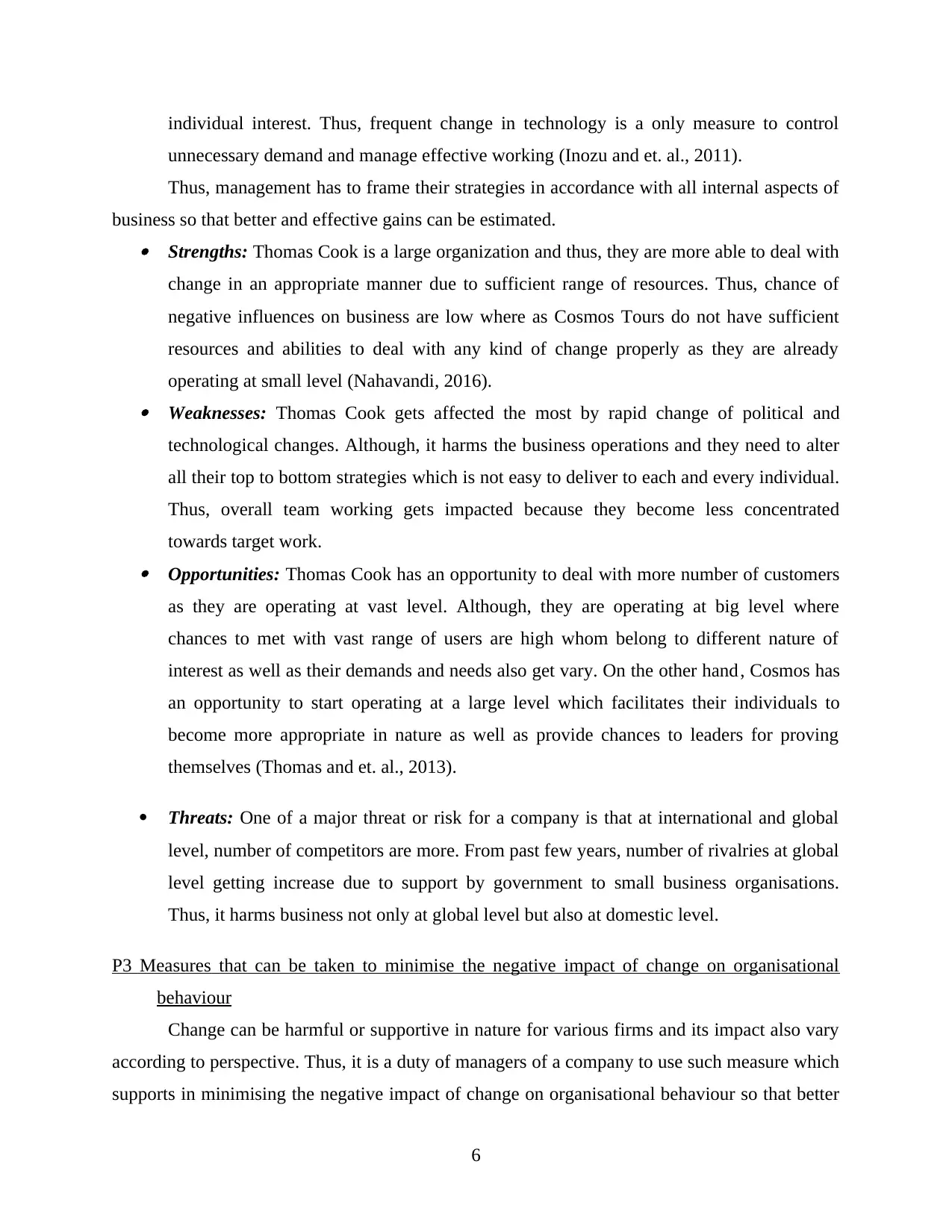
individual interest. Thus, frequent change in technology is a only measure to control
unnecessary demand and manage effective working (Inozu and et. al., 2011).
Thus, management has to frame their strategies in accordance with all internal aspects of
business so that better and effective gains can be estimated. Strengths: Thomas Cook is a large organization and thus, they are more able to deal with
change in an appropriate manner due to sufficient range of resources. Thus, chance of
negative influences on business are low where as Cosmos Tours do not have sufficient
resources and abilities to deal with any kind of change properly as they are already
operating at small level (Nahavandi, 2016). Weaknesses: Thomas Cook gets affected the most by rapid change of political and
technological changes. Although, it harms the business operations and they need to alter
all their top to bottom strategies which is not easy to deliver to each and every individual.
Thus, overall team working gets impacted because they become less concentrated
towards target work. Opportunities: Thomas Cook has an opportunity to deal with more number of customers
as they are operating at vast level. Although, they are operating at big level where
chances to met with vast range of users are high whom belong to different nature of
interest as well as their demands and needs also get vary. On the other hand, Cosmos has
an opportunity to start operating at a large level which facilitates their individuals to
become more appropriate in nature as well as provide chances to leaders for proving
themselves (Thomas and et. al., 2013).
Threats: One of a major threat or risk for a company is that at international and global
level, number of competitors are more. From past few years, number of rivalries at global
level getting increase due to support by government to small business organisations.
Thus, it harms business not only at global level but also at domestic level.
P3 Measures that can be taken to minimise the negative impact of change on organisational
behaviour
Change can be harmful or supportive in nature for various firms and its impact also vary
according to perspective. Thus, it is a duty of managers of a company to use such measure which
supports in minimising the negative impact of change on organisational behaviour so that better
6
unnecessary demand and manage effective working (Inozu and et. al., 2011).
Thus, management has to frame their strategies in accordance with all internal aspects of
business so that better and effective gains can be estimated. Strengths: Thomas Cook is a large organization and thus, they are more able to deal with
change in an appropriate manner due to sufficient range of resources. Thus, chance of
negative influences on business are low where as Cosmos Tours do not have sufficient
resources and abilities to deal with any kind of change properly as they are already
operating at small level (Nahavandi, 2016). Weaknesses: Thomas Cook gets affected the most by rapid change of political and
technological changes. Although, it harms the business operations and they need to alter
all their top to bottom strategies which is not easy to deliver to each and every individual.
Thus, overall team working gets impacted because they become less concentrated
towards target work. Opportunities: Thomas Cook has an opportunity to deal with more number of customers
as they are operating at vast level. Although, they are operating at big level where
chances to met with vast range of users are high whom belong to different nature of
interest as well as their demands and needs also get vary. On the other hand, Cosmos has
an opportunity to start operating at a large level which facilitates their individuals to
become more appropriate in nature as well as provide chances to leaders for proving
themselves (Thomas and et. al., 2013).
Threats: One of a major threat or risk for a company is that at international and global
level, number of competitors are more. From past few years, number of rivalries at global
level getting increase due to support by government to small business organisations.
Thus, it harms business not only at global level but also at domestic level.
P3 Measures that can be taken to minimise the negative impact of change on organisational
behaviour
Change can be harmful or supportive in nature for various firms and its impact also vary
according to perspective. Thus, it is a duty of managers of a company to use such measure which
supports in minimising the negative impact of change on organisational behaviour so that better
6
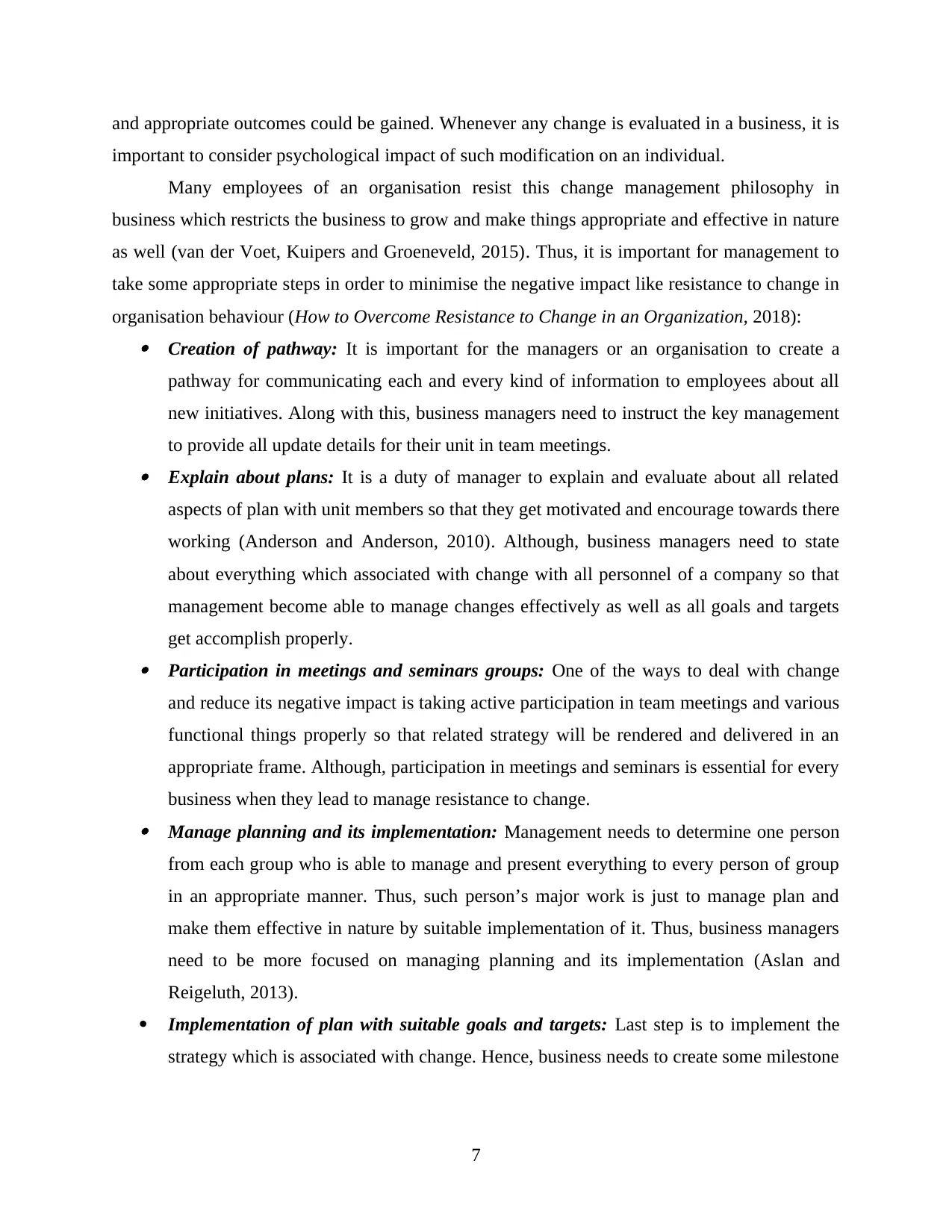
and appropriate outcomes could be gained. Whenever any change is evaluated in a business, it is
important to consider psychological impact of such modification on an individual.
Many employees of an organisation resist this change management philosophy in
business which restricts the business to grow and make things appropriate and effective in nature
as well (van der Voet, Kuipers and Groeneveld, 2015). Thus, it is important for management to
take some appropriate steps in order to minimise the negative impact like resistance to change in
organisation behaviour (How to Overcome Resistance to Change in an Organization, 2018): Creation of pathway: It is important for the managers or an organisation to create a
pathway for communicating each and every kind of information to employees about all
new initiatives. Along with this, business managers need to instruct the key management
to provide all update details for their unit in team meetings. Explain about plans: It is a duty of manager to explain and evaluate about all related
aspects of plan with unit members so that they get motivated and encourage towards there
working (Anderson and Anderson, 2010). Although, business managers need to state
about everything which associated with change with all personnel of a company so that
management become able to manage changes effectively as well as all goals and targets
get accomplish properly. Participation in meetings and seminars groups: One of the ways to deal with change
and reduce its negative impact is taking active participation in team meetings and various
functional things properly so that related strategy will be rendered and delivered in an
appropriate frame. Although, participation in meetings and seminars is essential for every
business when they lead to manage resistance to change. Manage planning and its implementation: Management needs to determine one person
from each group who is able to manage and present everything to every person of group
in an appropriate manner. Thus, such person’s major work is just to manage plan and
make them effective in nature by suitable implementation of it. Thus, business managers
need to be more focused on managing planning and its implementation (Aslan and
Reigeluth, 2013).
Implementation of plan with suitable goals and targets: Last step is to implement the
strategy which is associated with change. Hence, business needs to create some milestone
7
important to consider psychological impact of such modification on an individual.
Many employees of an organisation resist this change management philosophy in
business which restricts the business to grow and make things appropriate and effective in nature
as well (van der Voet, Kuipers and Groeneveld, 2015). Thus, it is important for management to
take some appropriate steps in order to minimise the negative impact like resistance to change in
organisation behaviour (How to Overcome Resistance to Change in an Organization, 2018): Creation of pathway: It is important for the managers or an organisation to create a
pathway for communicating each and every kind of information to employees about all
new initiatives. Along with this, business managers need to instruct the key management
to provide all update details for their unit in team meetings. Explain about plans: It is a duty of manager to explain and evaluate about all related
aspects of plan with unit members so that they get motivated and encourage towards there
working (Anderson and Anderson, 2010). Although, business managers need to state
about everything which associated with change with all personnel of a company so that
management become able to manage changes effectively as well as all goals and targets
get accomplish properly. Participation in meetings and seminars groups: One of the ways to deal with change
and reduce its negative impact is taking active participation in team meetings and various
functional things properly so that related strategy will be rendered and delivered in an
appropriate frame. Although, participation in meetings and seminars is essential for every
business when they lead to manage resistance to change. Manage planning and its implementation: Management needs to determine one person
from each group who is able to manage and present everything to every person of group
in an appropriate manner. Thus, such person’s major work is just to manage plan and
make them effective in nature by suitable implementation of it. Thus, business managers
need to be more focused on managing planning and its implementation (Aslan and
Reigeluth, 2013).
Implementation of plan with suitable goals and targets: Last step is to implement the
strategy which is associated with change. Hence, business needs to create some milestone
7
⊘ This is a preview!⊘
Do you want full access?
Subscribe today to unlock all pages.

Trusted by 1+ million students worldwide
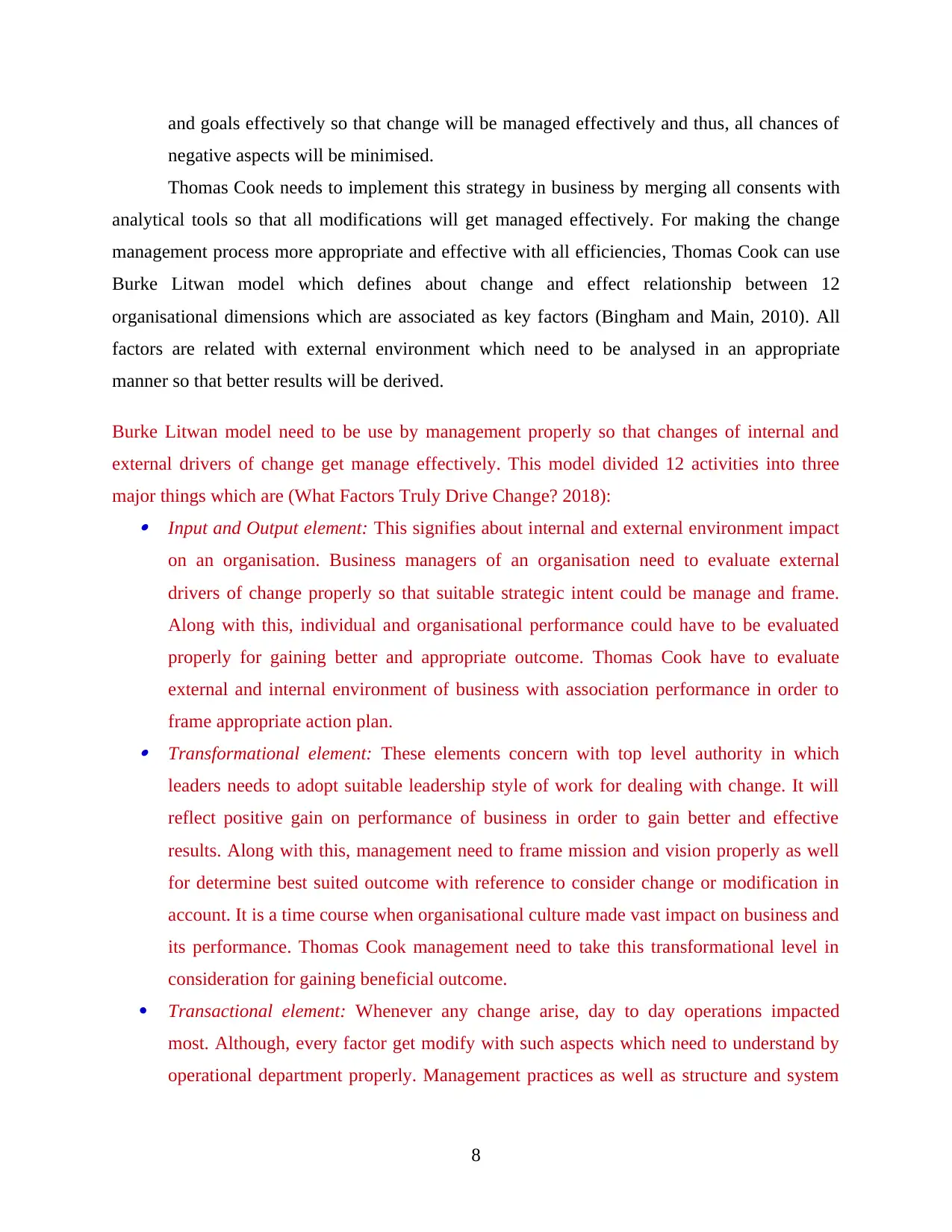
and goals effectively so that change will be managed effectively and thus, all chances of
negative aspects will be minimised.
Thomas Cook needs to implement this strategy in business by merging all consents with
analytical tools so that all modifications will get managed effectively. For making the change
management process more appropriate and effective with all efficiencies, Thomas Cook can use
Burke Litwan model which defines about change and effect relationship between 12
organisational dimensions which are associated as key factors (Bingham and Main, 2010). All
factors are related with external environment which need to be analysed in an appropriate
manner so that better results will be derived.
Burke Litwan model need to be use by management properly so that changes of internal and
external drivers of change get manage effectively. This model divided 12 activities into three
major things which are (What Factors Truly Drive Change? 2018): Input and Output element: This signifies about internal and external environment impact
on an organisation. Business managers of an organisation need to evaluate external
drivers of change properly so that suitable strategic intent could be manage and frame.
Along with this, individual and organisational performance could have to be evaluated
properly for gaining better and appropriate outcome. Thomas Cook have to evaluate
external and internal environment of business with association performance in order to
frame appropriate action plan. Transformational element: These elements concern with top level authority in which
leaders needs to adopt suitable leadership style of work for dealing with change. It will
reflect positive gain on performance of business in order to gain better and effective
results. Along with this, management need to frame mission and vision properly as well
for determine best suited outcome with reference to consider change or modification in
account. It is a time course when organisational culture made vast impact on business and
its performance. Thomas Cook management need to take this transformational level in
consideration for gaining beneficial outcome.
Transactional element: Whenever any change arise, day to day operations impacted
most. Although, every factor get modify with such aspects which need to understand by
operational department properly. Management practices as well as structure and system
8
negative aspects will be minimised.
Thomas Cook needs to implement this strategy in business by merging all consents with
analytical tools so that all modifications will get managed effectively. For making the change
management process more appropriate and effective with all efficiencies, Thomas Cook can use
Burke Litwan model which defines about change and effect relationship between 12
organisational dimensions which are associated as key factors (Bingham and Main, 2010). All
factors are related with external environment which need to be analysed in an appropriate
manner so that better results will be derived.
Burke Litwan model need to be use by management properly so that changes of internal and
external drivers of change get manage effectively. This model divided 12 activities into three
major things which are (What Factors Truly Drive Change? 2018): Input and Output element: This signifies about internal and external environment impact
on an organisation. Business managers of an organisation need to evaluate external
drivers of change properly so that suitable strategic intent could be manage and frame.
Along with this, individual and organisational performance could have to be evaluated
properly for gaining better and appropriate outcome. Thomas Cook have to evaluate
external and internal environment of business with association performance in order to
frame appropriate action plan. Transformational element: These elements concern with top level authority in which
leaders needs to adopt suitable leadership style of work for dealing with change. It will
reflect positive gain on performance of business in order to gain better and effective
results. Along with this, management need to frame mission and vision properly as well
for determine best suited outcome with reference to consider change or modification in
account. It is a time course when organisational culture made vast impact on business and
its performance. Thomas Cook management need to take this transformational level in
consideration for gaining beneficial outcome.
Transactional element: Whenever any change arise, day to day operations impacted
most. Although, every factor get modify with such aspects which need to understand by
operational department properly. Management practices as well as structure and system
8
Paraphrase This Document
Need a fresh take? Get an instant paraphrase of this document with our AI Paraphraser
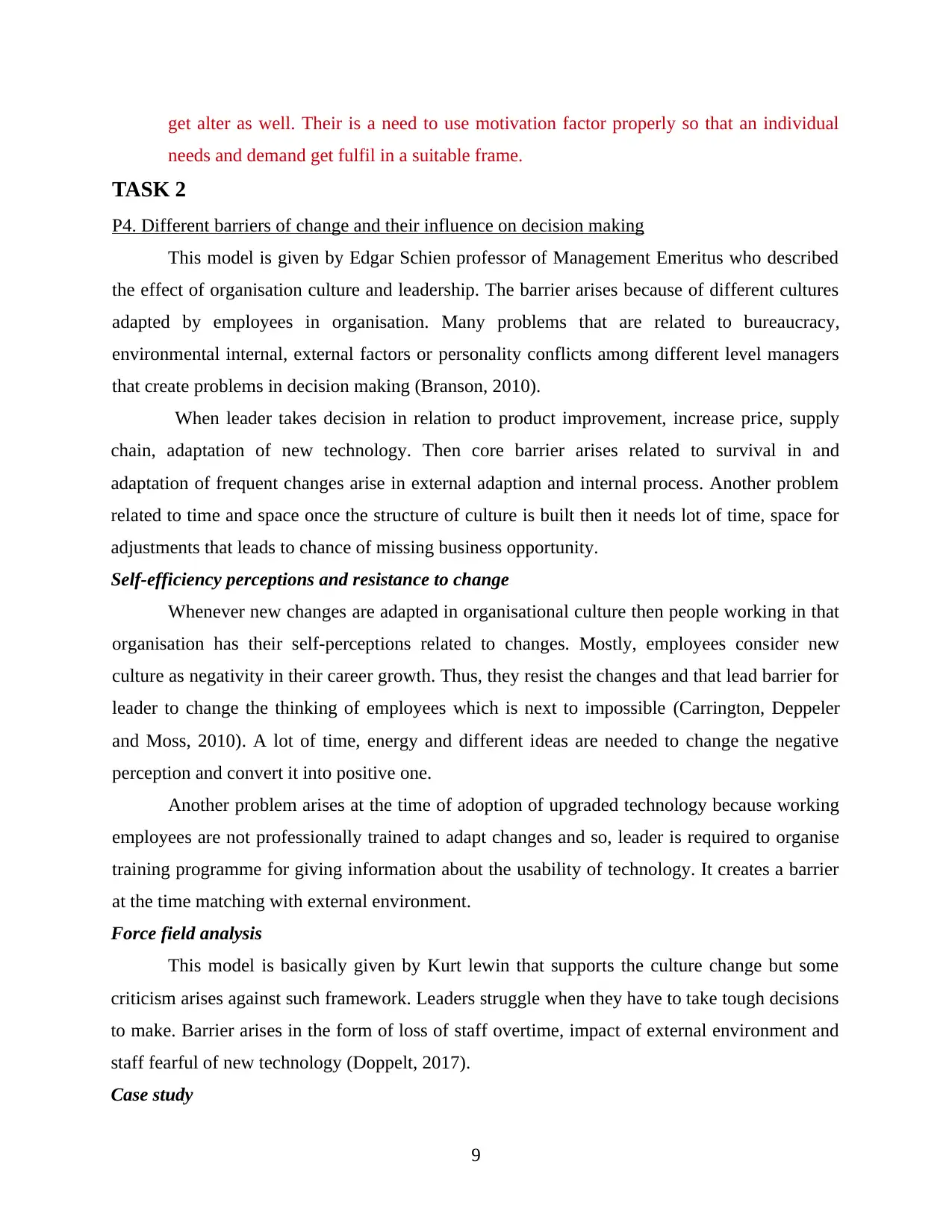
get alter as well. Their is a need to use motivation factor properly so that an individual
needs and demand get fulfil in a suitable frame.
TASK 2
P4. Different barriers of change and their influence on decision making
This model is given by Edgar Schien professor of Management Emeritus who described
the effect of organisation culture and leadership. The barrier arises because of different cultures
adapted by employees in organisation. Many problems that are related to bureaucracy,
environmental internal, external factors or personality conflicts among different level managers
that create problems in decision making (Branson, 2010).
When leader takes decision in relation to product improvement, increase price, supply
chain, adaptation of new technology. Then core barrier arises related to survival in and
adaptation of frequent changes arise in external adaption and internal process. Another problem
related to time and space once the structure of culture is built then it needs lot of time, space for
adjustments that leads to chance of missing business opportunity.
Self-efficiency perceptions and resistance to change
Whenever new changes are adapted in organisational culture then people working in that
organisation has their self-perceptions related to changes. Mostly, employees consider new
culture as negativity in their career growth. Thus, they resist the changes and that lead barrier for
leader to change the thinking of employees which is next to impossible (Carrington, Deppeler
and Moss, 2010). A lot of time, energy and different ideas are needed to change the negative
perception and convert it into positive one.
Another problem arises at the time of adoption of upgraded technology because working
employees are not professionally trained to adapt changes and so, leader is required to organise
training programme for giving information about the usability of technology. It creates a barrier
at the time matching with external environment.
Force field analysis
This model is basically given by Kurt lewin that supports the culture change but some
criticism arises against such framework. Leaders struggle when they have to take tough decisions
to make. Barrier arises in the form of loss of staff overtime, impact of external environment and
staff fearful of new technology (Doppelt, 2017).
Case study
9
needs and demand get fulfil in a suitable frame.
TASK 2
P4. Different barriers of change and their influence on decision making
This model is given by Edgar Schien professor of Management Emeritus who described
the effect of organisation culture and leadership. The barrier arises because of different cultures
adapted by employees in organisation. Many problems that are related to bureaucracy,
environmental internal, external factors or personality conflicts among different level managers
that create problems in decision making (Branson, 2010).
When leader takes decision in relation to product improvement, increase price, supply
chain, adaptation of new technology. Then core barrier arises related to survival in and
adaptation of frequent changes arise in external adaption and internal process. Another problem
related to time and space once the structure of culture is built then it needs lot of time, space for
adjustments that leads to chance of missing business opportunity.
Self-efficiency perceptions and resistance to change
Whenever new changes are adapted in organisational culture then people working in that
organisation has their self-perceptions related to changes. Mostly, employees consider new
culture as negativity in their career growth. Thus, they resist the changes and that lead barrier for
leader to change the thinking of employees which is next to impossible (Carrington, Deppeler
and Moss, 2010). A lot of time, energy and different ideas are needed to change the negative
perception and convert it into positive one.
Another problem arises at the time of adoption of upgraded technology because working
employees are not professionally trained to adapt changes and so, leader is required to organise
training programme for giving information about the usability of technology. It creates a barrier
at the time matching with external environment.
Force field analysis
This model is basically given by Kurt lewin that supports the culture change but some
criticism arises against such framework. Leaders struggle when they have to take tough decisions
to make. Barrier arises in the form of loss of staff overtime, impact of external environment and
staff fearful of new technology (Doppelt, 2017).
Case study
9
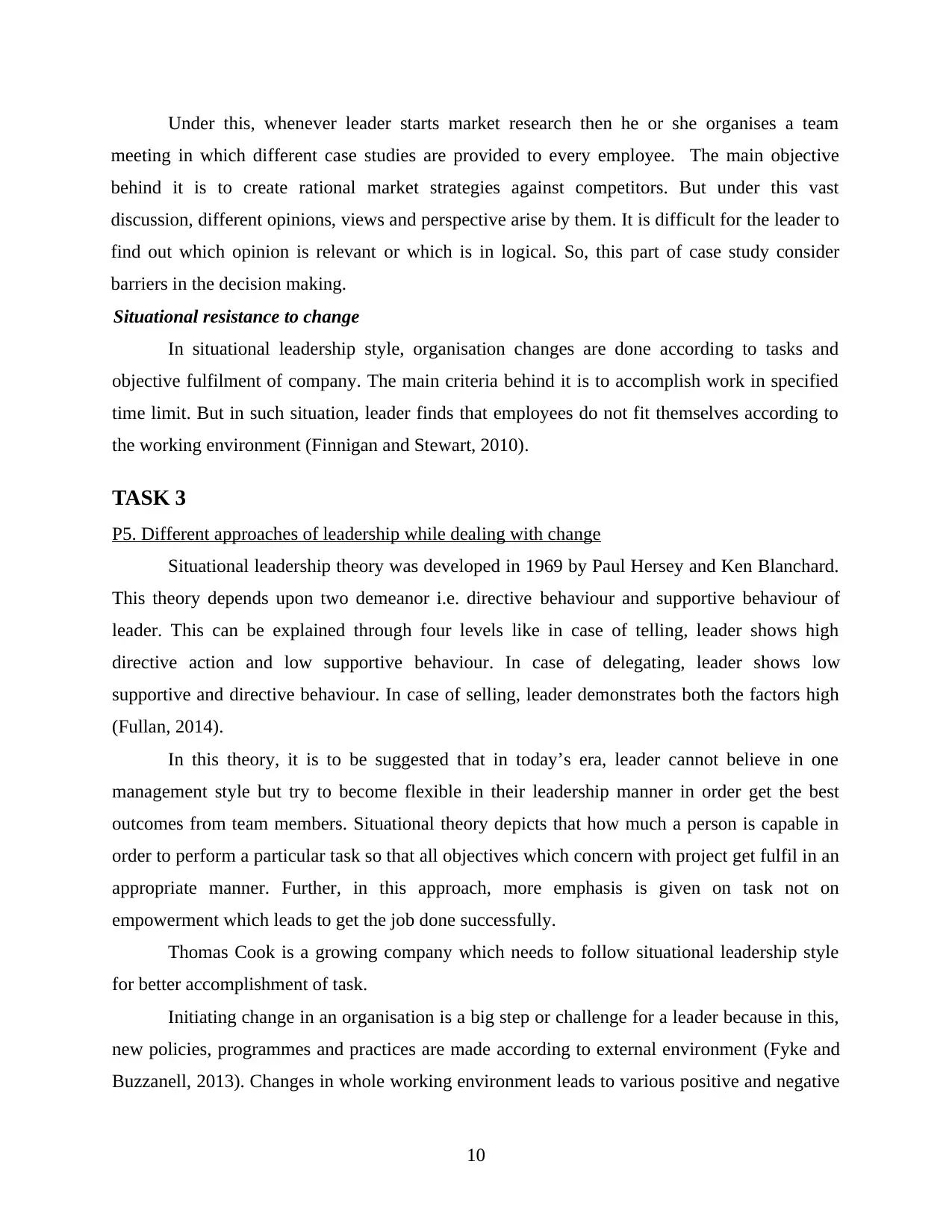
Under this, whenever leader starts market research then he or she organises a team
meeting in which different case studies are provided to every employee. The main objective
behind it is to create rational market strategies against competitors. But under this vast
discussion, different opinions, views and perspective arise by them. It is difficult for the leader to
find out which opinion is relevant or which is in logical. So, this part of case study consider
barriers in the decision making.
Situational resistance to change
In situational leadership style, organisation changes are done according to tasks and
objective fulfilment of company. The main criteria behind it is to accomplish work in specified
time limit. But in such situation, leader finds that employees do not fit themselves according to
the working environment (Finnigan and Stewart, 2010).
TASK 3
P5. Different approaches of leadership while dealing with change
Situational leadership theory was developed in 1969 by Paul Hersey and Ken Blanchard.
This theory depends upon two demeanor i.e. directive behaviour and supportive behaviour of
leader. This can be explained through four levels like in case of telling, leader shows high
directive action and low supportive behaviour. In case of delegating, leader shows low
supportive and directive behaviour. In case of selling, leader demonstrates both the factors high
(Fullan, 2014).
In this theory, it is to be suggested that in today’s era, leader cannot believe in one
management style but try to become flexible in their leadership manner in order get the best
outcomes from team members. Situational theory depicts that how much a person is capable in
order to perform a particular task so that all objectives which concern with project get fulfil in an
appropriate manner. Further, in this approach, more emphasis is given on task not on
empowerment which leads to get the job done successfully.
Thomas Cook is a growing company which needs to follow situational leadership style
for better accomplishment of task.
Initiating change in an organisation is a big step or challenge for a leader because in this,
new policies, programmes and practices are made according to external environment (Fyke and
Buzzanell, 2013). Changes in whole working environment leads to various positive and negative
10
meeting in which different case studies are provided to every employee. The main objective
behind it is to create rational market strategies against competitors. But under this vast
discussion, different opinions, views and perspective arise by them. It is difficult for the leader to
find out which opinion is relevant or which is in logical. So, this part of case study consider
barriers in the decision making.
Situational resistance to change
In situational leadership style, organisation changes are done according to tasks and
objective fulfilment of company. The main criteria behind it is to accomplish work in specified
time limit. But in such situation, leader finds that employees do not fit themselves according to
the working environment (Finnigan and Stewart, 2010).
TASK 3
P5. Different approaches of leadership while dealing with change
Situational leadership theory was developed in 1969 by Paul Hersey and Ken Blanchard.
This theory depends upon two demeanor i.e. directive behaviour and supportive behaviour of
leader. This can be explained through four levels like in case of telling, leader shows high
directive action and low supportive behaviour. In case of delegating, leader shows low
supportive and directive behaviour. In case of selling, leader demonstrates both the factors high
(Fullan, 2014).
In this theory, it is to be suggested that in today’s era, leader cannot believe in one
management style but try to become flexible in their leadership manner in order get the best
outcomes from team members. Situational theory depicts that how much a person is capable in
order to perform a particular task so that all objectives which concern with project get fulfil in an
appropriate manner. Further, in this approach, more emphasis is given on task not on
empowerment which leads to get the job done successfully.
Thomas Cook is a growing company which needs to follow situational leadership style
for better accomplishment of task.
Initiating change in an organisation is a big step or challenge for a leader because in this,
new policies, programmes and practices are made according to external environment (Fyke and
Buzzanell, 2013). Changes in whole working environment leads to various positive and negative
10
⊘ This is a preview!⊘
Do you want full access?
Subscribe today to unlock all pages.

Trusted by 1+ million students worldwide
1 out of 18
Related Documents
Your All-in-One AI-Powered Toolkit for Academic Success.
+13062052269
info@desklib.com
Available 24*7 on WhatsApp / Email
![[object Object]](/_next/static/media/star-bottom.7253800d.svg)
Unlock your academic potential
Copyright © 2020–2025 A2Z Services. All Rights Reserved. Developed and managed by ZUCOL.





